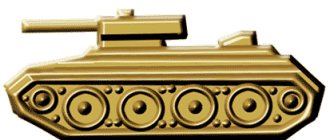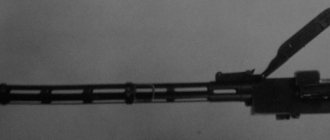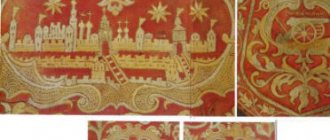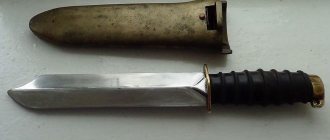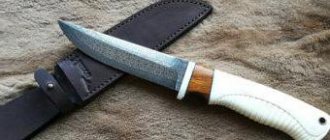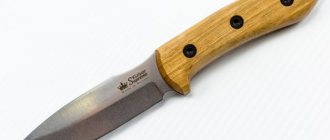Showdown of the medieval mafia
Since the Middle Ages, the Apennine Peninsula has been a real breeding ground for proud people, all armed and almost clutching their knives. The reason for this was not so much stereotypical Southern passion as political fragmentation.
The principalities and republics of the peninsula were constantly at odds with each other, as well as with the countries surrounding them, such as Spain or France. Constant internal and external wars made people's lives unstable, forcing them to be constantly on guard. Therefore, nobles, townspeople, and peasants tried to carry weapons with them.
Good old "Northerner"
A critical drawback of knives with chisel arches is that when cutting, they move in the direction opposite to the sharpened one. That is, they can be used somehow comfortably only with a certain position of the blade from the target. About 15 years ago, the idea began to sound that the location of the unilateral arch is determined by the “working hand,” which is akin to delirium. Why are you talking about the ancients? A universal field knife has no right to be intended only for one hand, this is a paradox, nonsense. What if a finger is knocked out on the “working” one? If it is inflamed and swollen, numb?
This does not happen in history, and real field practices that have nothing to do with catalytic marketing will never harbor harmful entities. This is just a good old “northerner”, which is convenient to sharpen without having factory stones. By the way, all attempts not only to justify, but also to exalt the “lens” on one side of the blade are no less ridiculous. Try to sharpen a knife on sandstone over the course of a season, and you will inevitably see a “lens” on any blade. Let's leave pseudoscientific talk about the certain convenience of such a form for successful planing to the wind. Please note: for planing, including complex surfaces, the skilled Yakuts had separate knives that were bent according to the required pattern. And later an ax and a plane appeared.
However, there is an important detail that distinguishes Yakut knives from other northern knives - one-sided blade. Yes, yes, that very “bloodstock”. Here the fantasy of marketers is in full swing, right down to the reference to Paleolithic bone knives made from shin bone with an open cavity, a “natural valley”... Let’s immediately shoot the “bone version” so as not to be confused. The Kurakans, who were among the dozen chosen tribes invited to the funeral of the first Khagans, were a very civilized people, what the hell are the bones? By the way, the author of the article tried to make such a knife from tubular bone. And you can do this with your “dremel” or a metal saw, cutting the elk’s shin bone lengthwise. What will you plant in the taiga? With a steel knife or a stone? The labor costs during production will be hellish, and the service life will be meager. The Tungus had such things, not a model to imitate and not the best option, except for a club-sword. It is much more effective to have the simplest scrapers made from a spatula. Why is it needed? Now we have reached the main question. As is known, by reducing the weight of the blade, it allows you to maintain strength. However, on a knife it is useful only because of the length and weight of the Caucasian dagger-kama; on a short and light knife it makes no sense at all. But “Yakut” has it! Damn it, why? After all, it seems that on this, sometimes deliberately poorly processed and difficult to clean surface, it is not practical meaning that can settle, but only harmful bacteria. Here is the answer: yes, the “Yakut”, unlike the knife of the Trans-Baikal era, has lost its obvious combat significance. But not completely... Do you remember what first catches your eye when looking at this knife? Exactly the dollar. Take it away, and the Yakut knife completely loses its charm. Having extensive experience in steppe wars, the ancestors of the Yakuts perfectly understood the significance of the psychological impact of the blade. A frightening detail, shape or bright shine that doesn’t allow your eyes to leave... This technique is masterfully mastered, for example, by knife maker Gil Hibben, remember his Double Shadow with an ominous end-to-end threat on the blade. Creepy. Having abandoned belligerence, the Yakuts did not at all abandon military cunning. Working as a contrasting detail, a dominant feature that catches the eye, it automatically hints at the owner’s belligerence, his determination to take the next step, instantly moving from touches to shredding the enemy. A necessary detail, it turns out! That's the whole mystery. Therefore, do not listen to the cunning marketers of the new time with their complex and unconvincing attempts to make a “knife with a complex cross-section” and a “tool for all cases,” including planing of entire pine trees. It is not for everything in general, but for ordinary small work in the field. Just buy a Yakut knife and enjoy the glorious ethnicity of many centuries. And looking at the rough forged valley, feel a surge of determination and awareness: with such a knife in your hand, you will immediately become three times more dangerous, I answer.
Vadim Denisov - hуpe.ru
Share:
Bulli - fanfare from the outskirts
But not only bandits were famous throughout Italy as inveterate lovers of knives. Bullies were much more popular among the people - an interesting subculture that formed on the outskirts of cities and in slums, a kind of mixture of English fashionable dandies and our modern gopniks.
Despite widespread poverty, they tried to dress smartly, play cards and lead a riotous life. Aggressive and reckless behavior was part of their style and way of life, which, in the presence of knives, regularly led to murder.
However, their fights were not just drunken brawls. Most often, they had all the features of a duel - a challenge to a fight, seconds, and other attributes. The fact that this took place in the slums, and the opponents cut each other's guts out with knives and not noble swords, did not matter. Group massacres also occurred frequently.
A knife is not always a bladed weapon
This article can be safely recommended as a reminder to carry with you to many, even experienced hunters and fishermen. And for beginners, don’t bother with registered edged weapons at all, but purchase original and serial copies of the so-called “household goods” or “tourists”, which mainly include the samples below. In terms of most operational characteristics, they are no worse than “real” hunting and so-called ones. tactical knives, but they won’t cause problems (if you have this instruction) if something happens. Well, for example, few newcomers realize how many license plates are left to rust in the forests, stuck and forgotten in stumps and trees. So much has been lost and fallen into the wrong hands. Do you need it?
In accordance with GOSTs, knives that meet the following requirements (at least one) are not considered weapons:
Knives whose blades are not adapted for stabbing are not weapons:
1. Knives without a tip. The tip can be replaced with any tool (screwdriver, chisel more than 3 mm wide), or rounded.
The blade edge of the Katran-1 knife from NOKS is deliberately blunted and has a plane more than 3 mm wide. This is the only sign that classifies these products into the household household category. (you must remember that when sharpening the edge of the blade, the parameters of the product change and these knives can easily turn into edged weapons with all the ensuing consequences).
2. Knives with an edge located above the spine line by more than 5 mm.
Approximate diagram of a knife corresponding to feature No. 2. It should be noted that knives that meet this characteristic have no restrictions on the length of the blade and the presence of finger stops.
This Tanto style knife has a blade length of 188 mm and a tip located above the butt line by more than 5 mm.
The Vityaz Cayman knife has a blade length of 210 mm and a tip located above the spine line by more than 5 mm.
3. Knives with a maximum deflection of the blade spine of more than 5 mm for a blade length of up to 180 mm and more than 10 mm for a blade length of more than 180 mm.
Approximate diagram of a knife corresponding to feature No. 3.
This knife has a blade length of 158 mm and a deflection of the blade spine (distance h in the diagram) of more than 5 mm.
4. Knives with a spine concave by more than 5 mm, with a blade length of up to 180 mm.
This knife has a blade length of 130 mm and a tip located below the butt line by more than 5 mm.
5. Knives with a concave angle of more than 10mm. butt, with a blade length of more than 180 mm.
This knife has a blade length of 200 mm and a tip located below the butt line by more than 10 mm.
6. Knives, on the butt of which, no further than 1/3 from the tip, there is a sharpened hook for ripping skins.
Approximate diagram of a knife corresponding to feature No. 6.
7. Knives in which the amount of deflection of the butt and the upper part of the handle of the knife, which has the shape of an arc in the form of a “rocker”, upward from the conventional straight line connecting the tip of the blade and the upper end of the handle, exceeds 15 mm.
8. Knives with a blade shorter than 90mm.
A set of two daggers with a blade length of 80 mm each.
9. Knives in which the blade and spine, or the main one and the one made on the spine, converge at an angle of more than 70 degrees.
The Bivack knife from NOX has a convergence angle of the blade and butt of 70+ degrees.
The angle of convergence of the blade and butt.
10. Knives are thicker than 5-6mm.
11. Knives without a sharpened blade (the triggers are removed, but the RK is missing).
Knives with a handle that does not provide a reliable hold when pricking:
The absence of stops (limiters for fingers) on this dagger makes its handle dangerous in the event of a stabbing blow; this is the only sign classifying this product as a household item, etc. If you add stops to its design, the dagger becomes a 100% melee weapon, you can even “don’t go to a fortune teller..” (fans of improvements need to remember this point).
12. Knives with handles shorter than 70mm.
This Harpy butcher knife from NOX has a handle length of 40 mm. It also corresponds to feature No. 8 since it has a blade 70 mm long.
13. Knives with a barrel-shaped handle, in which the difference between the maximum diameter in the middle part of the barrel-shaped handle and the minimum diameter in the pommel area does not exceed 8 mm.
Approximate diagram of a knife corresponding to feature No. 13 (Dmax - Dmin no more than 8 mm).
The Vityaz dagger B110-33 has a boundary between the maximum diameter in the middle part of the barrel-shaped handle and the minimum diameter in the pommel area of no more than 8 mm.
14. Knives with a single (one-sided, or two-sided in total) limiter or a single finger groove less than 5 mm.
15. Knives that have more than one notch or limiter, their size should be less than 4 mm.
In the diving and extreme tourism knife "Storm" from SARO, the heel of the blade, which acts as a limiter, is deliberately narrowed and has a thickness of 3.5 mm, while thickening of the blade towards the tip is allowed (the thickness of the butt of the "Storm" knife is 4.0+ mm).
Knives that do not provide the required strength of the blade or the entire structure:
16. Knives with blades whose hardness is less than 25HRC.
The blade hardness of this replica AK-47 bayonet does not exceed 25HRC.
17. Knives with a developed stop or finger groove, with a blade length of up to 150 mm and a thickness of less than 2.5 mm. This feature includes a huge number of knives, including those of excellent quality. All knives with a straight blade (up to 150 mm), a pronounced edge (the angle of convergence of the blade and spine is less than 70 degrees), developed finger stops or finger grooves and are freely sold in the Russian Federation, have a spine thickness of less than 2.5 mm (usually 2.2 -2.4), otherwise it is no longer possible to sell freely, while the hardness of the blade has no restrictions. Such knives are considered as allegedly “not providing the necessary strength of the blade or the entire structure.” All this is very relative; a knife with a blade thickness of 2.2 mm is capable of helping its owner out in almost any situation.
The Ferret knife has a blade length of 130 mm and a spine thickness of 2.2 mm.
The Smersh-5 knife from Melita has a blade length of 150 mm and a spine thickness of 2.2 mm.
18. Knives with sawed blades.
19. Knives with blades made of materials that do not provide sufficient strength for weapons (silumin, aluminum, plastic).
20. Knives with a weak blade seal that does not hold the blade in the handle during combat use of the knife (the blade tang is loosely inserted into the handle and filled with sealing wax).
It is allowed to sharpen the butt of the knife one and a half times, to a length of no more than 2/3 of the butt.
It is allowed to place additional tools on the butt of the knife, such as saws for wood, metal, bone, and a sling cutter.
And further. When purchasing a knife in a store, ask for a Certificate (also called an “Information Sheet”), which states that the knife is not a bladed weapon and belongs to household, tourist, or other knives. It is advisable to carry this Information Sheet and this Memo with you, which will allow you to significantly save your time in case of questions from law enforcement agencies. And nerves.
Arditi - Italian assault troops of the First World War
The Italian authorities could not get rid of the custom of knife fights until the beginning of the 20th century, and the First World War helped them in this. In Italian society of that time, killing an enemy with a knife was considered honorable, and reporting to the police was considered shameful. But by the end of the 19th century, the laws were tightened, and the colossal war that broke out became the last striking episode in the history of knife fights. True, this already happened at the front.
A fact is a fact
The knife carried has also changed. A typical “northerner” appeared on the belt with a straight and oval-shaped wooden handle, the most convenient shape for working with mittens. I also call it anti-arthritis. The shorter blade of such a knife is often narrower than the handle and has a “belly”, the sheath is deep, submersible. The higher the latitude, the narrower the blade, up to the very narrow ones of the Nganasans, the northernmost ethnic knives of the planet, which were often made from halves of scissors. In addition, the narrow blade does not stick to the skin in wider sheaths. They are comfortable whitening deer, repairing light prefabricated utensils and sleds. In addition, with a narrow blade it is more convenient to grab a piece of meat near the lips, holding it between your teeth. In general, nothing unique. Like many Tunguskas, this knife had a one-sided asymmetrical arch of the blade. Since ancient times, this sharpening in the Russian North was called “fish” - to fillet the catch, and only that. However, this form has a significant advantage: it is convenient to sharpen the knife “on the knee”, on any suitable stone with a more or less even surface. Put it on one side, and go ahead. And due to the low quality of the metal, it was necessary to sharpen it often. Actually, the advantages end there, however, the factor of convenience and speed of sharpening with obtaining a relatively small arch angle turned out to be more important. None of the Yakuts of the past could have imagined that descendants and explorers, riding on snowmobiles and having all the benefits of civilization, would begin to look for some advantages in this form va, pulling by the ears the compo-mat and the theory of reza. If it were possible, they would also attract the theory of machines and mechanisms. This is the similarity between the mythology of the Yakut knife and the legend of the katana. Marketing, and not the practice of life, required some justification, and they are tirelessly, ridiculously, looking for it. But the fact remains - any withdrawal of the cutting edge (PK), as well as the tip of the blade, from the main axis in any plane passing through the handle and the user’s grip inevitably causes m notes, withdrawals. It is possible to get rid of them only by doing exclusively specific work. Therefore, they do not prick the Uzbek bee, working in a steep arc towards the tip. Yakut, like any “northerner”, is convenient to plan on the weight or with a stop (planing). But the northern life support system does not provide a table with a cutting board, as well as “neat cooking.” All modern attempts to justify the appearance of “Yakut” in the kitchen of a city apartment are naive. The knife is inconvenient for everyday kitchen work, as any professional chef will tell you, including the Japanese, who uses a chisel sharpening for very narrow fish operations. . I advise the average person, who uses a field knife by force once a month when going out into the forest, to more often turn to the experience of the pros: cooks and cutters, whose tools have long been verified and regulated an - from a chef's troika to a set of knives for commercial deer shooters. There is no “chisel” there... As you know, the cut consists of a stroke and a feed. If with the progress on the cutting board of the “northerner” everything is more or less normal, then with the presentation - vertical introduction into the material - things are bad. The wide handle and the brush itself get in the way, a small section of the blade works. The same inconveniences arise with the external stop-limiter, the PK line is located too high. This is why in the kitchen you use knives with an internal stop, when the blade is located below the hand - take out your “chef” and look.
Restrictions by law
In Russia, restrictions have been imposed on a number of weapons that pose a danger to humans. In some cases, the law prohibits the purchase or use of them, even if the person has a permit to carry and possess dangerous items.
These prohibitions apply equally to civilians and government employees. Such weapons include:
- Boomerangs, shurikens, brass knuckles, which are currently no longer items of defense. With the exception of the throwing ball, this category can also include all throwing, piercing, slashing and impact-crushing weapons.
- Store and use knives that are manufactured with automatic blade extraction, the length of which should be more than 9 cm.
In Russia, the law regulates the sending of military, military or sporting weapons by mail. It is strictly prohibited to bring such dangerous objects with you to rallies or various meetings and demonstrations.



